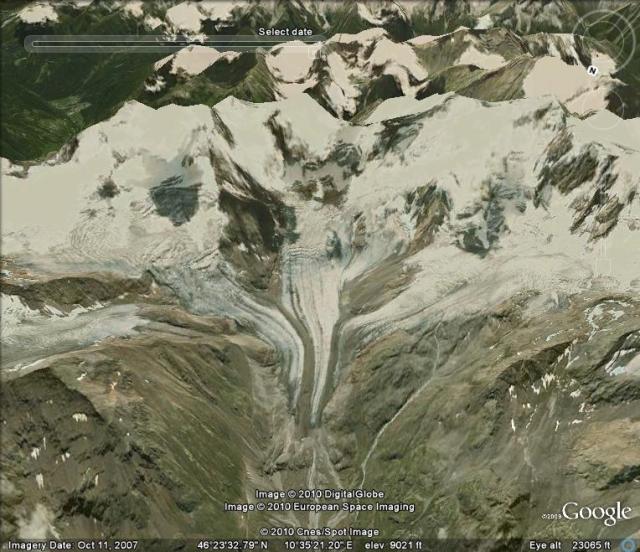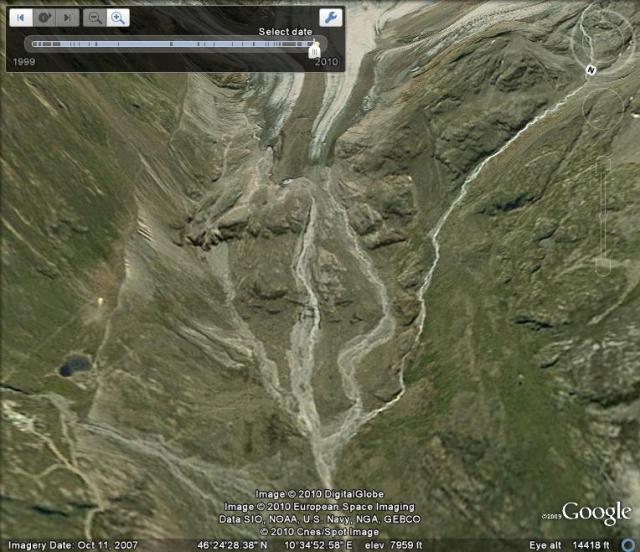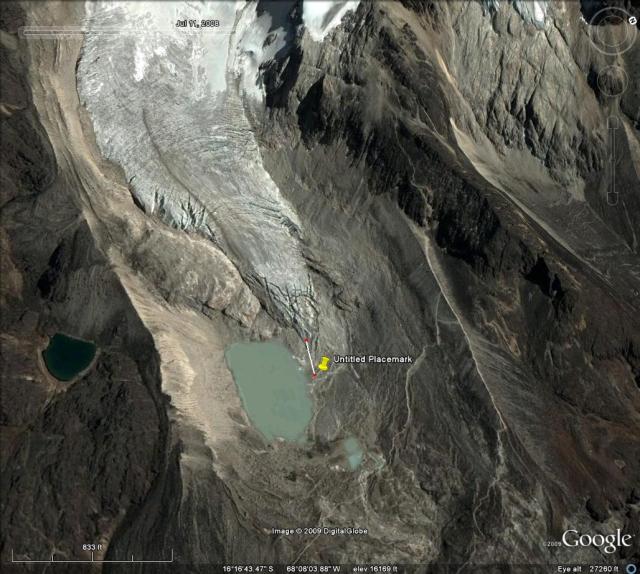Forni Glacier is the largest valley glacier in Italy. It is currently 5 km long and has retreated 2.5 kilometers since its Little Ice Age Maximum. It is in the Cevedale Group, Alps and part of the Parco Nazionale dello Stelvio. In this image the Little Ice Age terminal moraine is the prominent sharp debris ridge in the foreground, twenty years ago the glacier descended beyond the bottom of the image. The Italian Glaciologic Commission has observed and reported its annual terminus change over the last 30 years to the World Glacier Monitoring Service. The glacier began a sustained retreat in 1988, after advancing a small distance in the 1970-1987 period. As reported by the IGC to the WGMS from 1990-1995 Forni Glacier retreated 290 m, between 1995 and 2000 130 m, and from 2000-2005 115 m. Using IKONOS (Bellingeri and Zini, 2006 stereoscopic high resolution imagery linear retreat of the glaciers tongue was established as 520 meters for Forni Glacier in the 1981-2003 period. The glacier was found to have lost an average of 15 m in thickness in this period, 60 m near the terminus. The glacier as seen below above the key icefalls has a substantial consistent accumulation zone. It is the terminus tongue below the icefall that is at risk with current climate.
stereoscopic high resolution imagery linear retreat of the glaciers tongue was established as 520 meters for Forni Glacier in the 1981-2003 period. The glacier was found to have lost an average of 15 m in thickness in this period, 60 m near the terminus. The glacier as seen below above the key icefalls has a substantial consistent accumulation zone. It is the terminus tongue below the icefall that is at risk with current climate.  A close up view of the terminus illustrates the region that has been deglaciated in the last 20 years, there is virtually no green vegetation evident in this region. The lower section of the glacier is rapidly downwasting still.
A close up view of the terminus illustrates the region that has been deglaciated in the last 20 years, there is virtually no green vegetation evident in this region. The lower section of the glacier is rapidly downwasting still. 
Tag: climate change glacier
Zongo Glacier retreat
Zongo Glacier, Bolivia extends 2.9 km down the south side of Huayna Potosi from 6000 m to 4900 m. Zongo Glacier is a small valley glacier located north-east of La Paz, and its runoff is directed to an important hydraulic power station which supplies La Paz. Note Laguna Zongo in foreground of the first image. The dam is visible as is the power station to the right and below the lake. The glacier has considerable snowcover on its upper section and crevassing. This indicates a persistent accumulation zone.  In 1991 a glaciological research program (page 46) was established on Zongo Glacier to monitor mass balance, understand its hydrology and energy balance. The long term director of this research Bernard Francou has been called the glacier guardian. The typical Alpine glaciers undergoes a long accumulation period in winter and a short ablation season in summer. The glaciers of the tropical Andes experience snow accumulation during the wet season, austral summer on their upper regions and maximum ablation during the same season low on the glacier. In the dry season winter there is a period of low ablation over the whole glacier. Mean annual air temperature at the long term snowline at 5250 m is -1.5 °C. Mean precipitation is about 0.9 m/year.
In 1991 a glaciological research program (page 46) was established on Zongo Glacier to monitor mass balance, understand its hydrology and energy balance. The long term director of this research Bernard Francou has been called the glacier guardian. The typical Alpine glaciers undergoes a long accumulation period in winter and a short ablation season in summer. The glaciers of the tropical Andes experience snow accumulation during the wet season, austral summer on their upper regions and maximum ablation during the same season low on the glacier. In the dry season winter there is a period of low ablation over the whole glacier. Mean annual air temperature at the long term snowline at 5250 m is -1.5 °C. Mean precipitation is about 0.9 m/year.
Since 1991 the glacier has lost more than 5 m of thickness and has retreated significantly. The mass balance loss has been most pronounced during El Nino periods, thus 2009 should not be a good year for Zongo Glacier. La Nina’s are associated with positive or only slightly negative mass balance. The ongoing mass balance loss has led to retreat of 184 meters of this glacier from 1996-2005. A comparison of satellite images from 2004-2008 indicate a retreat of 70-75 meters, this is consistent with the reported retreat rate of 18 meters per year. The glacier has withdrawn from the new glacier lake formed from the ongoing glacier retreat in the 1990’s. The images below are focussed on the terminus in 2004 and in 2008, note the retreat from the lake shore. 

Zongo Glacier continues to have an accumulation zone, a necessary essential for glacier survival, and unlike the nearby Chacaltaya Glacier which has disappeared in 2009, it will exist for sometime. The Chacaltaya Glacier is a small glacier, like 80% of the glaciers in this region of the Cordillera Real, and its disappearance puts more pressure on the water resources provided by the larger remaining glaciers such as Zongo Glacier.
